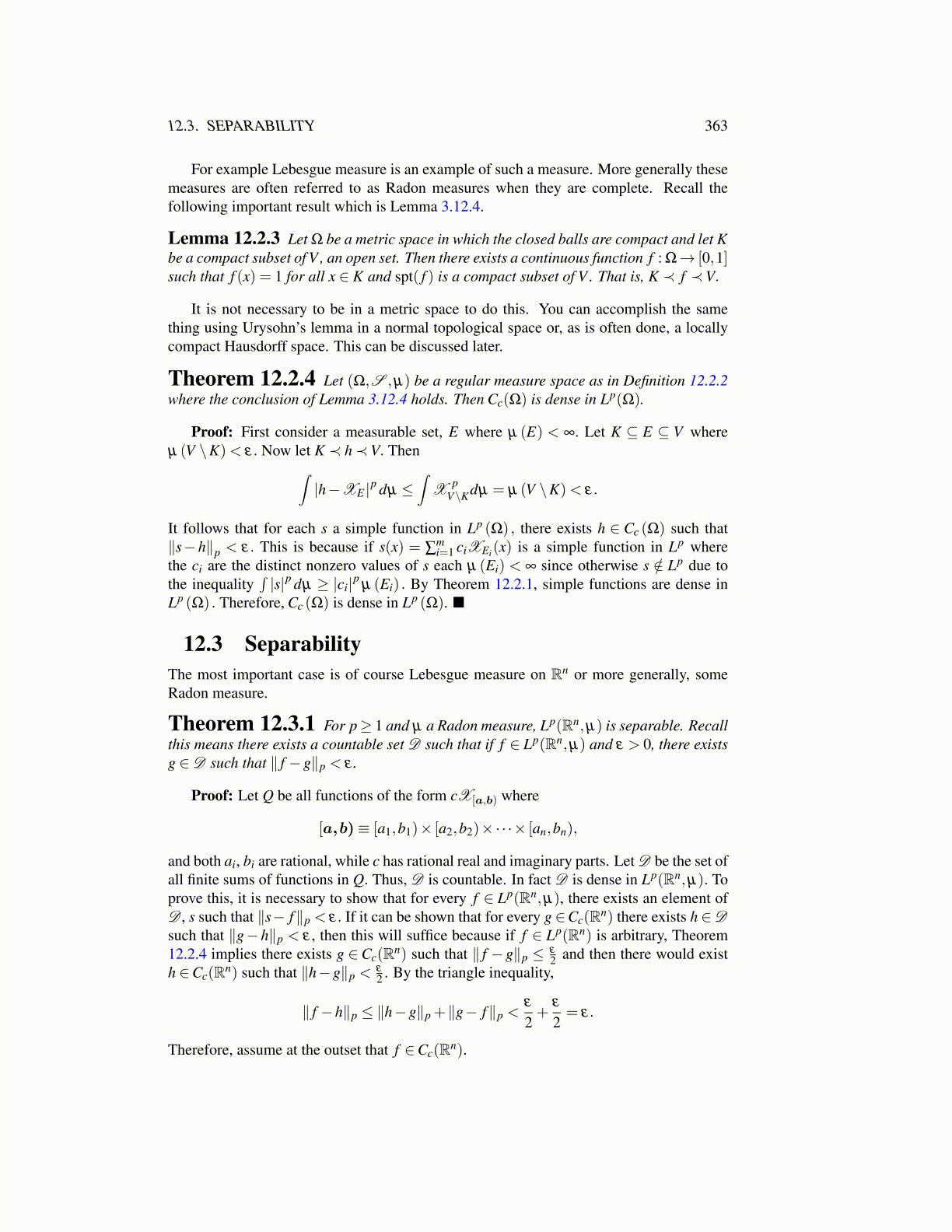
12.3. SEPARABILITY 363
For example Lebesgue measure is an example of such a measure. More generally thesemeasures are often referred to as Radon measures when they are complete. Recall thefollowing important result which is Lemma 3.12.4.
Lemma 12.2.3 Let Ω be a metric space in which the closed balls are compact and let Kbe a compact subset of V , an open set. Then there exists a continuous function f : Ω→ [0,1]such that f (x) = 1 for all x ∈ K and spt( f ) is a compact subset of V . That is, K ≺ f ≺V.
It is not necessary to be in a metric space to do this. You can accomplish the samething using Urysohn’s lemma in a normal topological space or, as is often done, a locallycompact Hausdorff space. This can be discussed later.
Theorem 12.2.4 Let (Ω,S ,µ) be a regular measure space as in Definition 12.2.2where the conclusion of Lemma 3.12.4 holds. Then Cc(Ω) is dense in Lp(Ω).
Proof: First consider a measurable set, E where µ (E) < ∞. Let K ⊆ E ⊆ V whereµ (V \K)< ε. Now let K ≺ h≺V. Then∫
|h−XE |p dµ ≤∫
X pV\Kdµ = µ (V \K)< ε.
It follows that for each s a simple function in Lp (Ω) , there exists h ∈ Cc (Ω) such that∥s−h∥p < ε. This is because if s(x) = ∑
mi=1 ciXEi(x) is a simple function in Lp where
the ci are the distinct nonzero values of s each µ (Ei) < ∞ since otherwise s /∈ Lp due tothe inequality
∫|s|p dµ ≥ |ci|p µ (Ei) . By Theorem 12.2.1, simple functions are dense in
Lp (Ω) . Therefore, Cc (Ω) is dense in Lp (Ω). ■
12.3 SeparabilityThe most important case is of course Lebesgue measure on Rn or more generally, someRadon measure.
Theorem 12.3.1 For p≥ 1 and µ a Radon measure, Lp(Rn,µ) is separable. Recallthis means there exists a countable set D such that if f ∈ Lp(Rn,µ) and ε > 0, there existsg ∈D such that ∥ f −g∥p < ε .
Proof: Let Q be all functions of the form cX[a,b) where
[a,b)≡ [a1,b1)× [a2,b2)×·· ·× [an,bn),
and both ai, bi are rational, while c has rational real and imaginary parts. Let D be the set ofall finite sums of functions in Q. Thus, D is countable. In fact D is dense in Lp(Rn,µ). Toprove this, it is necessary to show that for every f ∈ Lp(Rn,µ), there exists an element ofD , s such that ∥s− f∥p < ε. If it can be shown that for every g ∈Cc(Rn) there exists h ∈Dsuch that ∥g− h∥p < ε , then this will suffice because if f ∈ Lp(Rn) is arbitrary, Theorem12.2.4 implies there exists g ∈Cc(Rn) such that ∥ f − g∥p ≤ ε
2 and then there would existh ∈Cc(Rn) such that ∥h−g∥p <
ε
2 . By the triangle inequality,
∥ f −h∥p ≤ ∥h−g∥p +∥g− f∥p <ε
2+
ε
2= ε.
Therefore, assume at the outset that f ∈Cc(Rn).